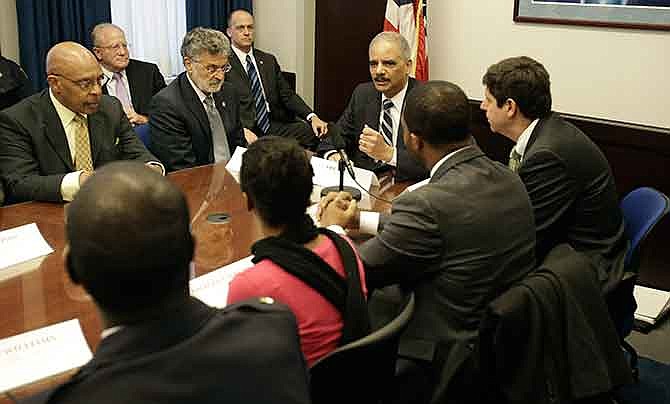CLEVELAND (AP) - A commitment to community policing is one of the key reforms the U.S. Department of Justice expects from the Cleveland police after issuing a report that says officers too often use excessive force and violate people's civil rights.
Assistant Attorney General Vanita Gupta said at a news conference Thursday led by Attorney General Eric Holder that accountability and community policing make the job of delivering police services easier and safer.
The DOJ spent 18 months investigating use of force policies in Cleveland after a series of well-publicized incidents, including the killing of two unarmed civilians in a hail of police gunfire after a high-speed chase.
The Justice Department's finding will result in city officials, community leaders and others devising a plan to reform the police department. That plan must be approved by a federal judge and will be overseen by an independent monitor.
The report issued by the DOJ takes to task the entire department, from patrol officers to police brass. It criticizes officers for endangering the lives of citizens and fellow officers by unnecessarily firing their guns, hitting suspects in the head with their weapons and punching and using Tasers on people who are already handcuffed.
This was the second time the Justice Department has conducted an investigation of excessive force by Cleveland police. In 2004, the DOJ left it up to Cleveland to fix its problems.
"We understand the progress we seek will not come overnight," Attorney General Eric Holder said at Thursday's news conference.
Efforts at changing the department's culture by instituting community policing tactics were tried in the 1990s without much success.
Mayors in Cleveland have for decades struggled to rein in a police department that patrols neighborhoods where people often are distrustful. Police officers, in turn, often don't trust the people they're sworn to protect. Mayor Frank Jackson was among those that urged the DOJ to come to Cleveland to investigate the department.
The report references an interview with a former police commander who "believes the culture within (the department) is antithetical to a community policing mentality and that officer training instills in officers an 'us-against-them' mentality." One of the primary facets of community policing requires officers to leave their patrol cars and to engage residents instead of just answering radio calls and arresting them.
The DOJ report detailed various instances of how police used force, lethal and otherwise, where investigators believed de-escalation - such as a conversation - would have been more effective.
The department's investigators refer to an incident in which an officer punched a handcuffed 13-year-old boy who had kicked him and tried to escape from a patrol car. The supervisor, the report said, called the punches "arguably the best response."
Chief Calvin Williams stood to the side of Jackson during the news conference. He said the DOJ report would be difficult to share with his 1,500-member department but vowed to implement change.
"The people of this city need to know we will work to make the police department better," Williams said.
Associated Press writers Jennifer Smola in Cleveland and John Seewer in Toledo contributed to this report.
Cleveland cases deemed unreasonable use of force
Among the Cleveland police confrontations cited Thursday by the U.S. Department of Justice as unreasonable or excessive use of force:
RESTRAINED AND KICKED
After leading officers on a brief chase, a man got out of his van and walked into a group of trees. An officer approached the man with his weapon drawn, and the man followed commands to lie down on the ground and spread his arms and legs. After the man was restrained and on his stomach, officers began kicking and striking the man. He was later taken to the hospital with a broken bone near his eye.
13-YEAR-OLD PUNCHED
After officers arrested a 13-year-old boy for shoplifting, he was handcuffed and placed in a police vehicle, where he began kicking the door and an officer in the leg. The officer then sat on the legs of the handcuffed boy and punched him three to four times until the boy was "stunned" and had a bloody nose.
STUNNED WHILE STRAPPED TO GURNEY
Officers assisted a man who had suffered several seizures into an ambulance, where he was strapped onto a gurney. The man became angry and tried to unstrap himself, balling his fist. An officer threatened to use a stun gun on him, but the man continued to try to stand up and threatened to hurt the officer. The officer then stunned him while he was still strapped to the gurney.
PEPPER SPRAYED IN CUFFS
Officers placed a mentally ill man in handcuffs for making threats to "blow up the government." Because the man was spitting on officers, they placed a hood - called a spit sock - over the man's head. When the man was placed in the police vehicle, he kicked at the windows and continued to spit. An officer ordered him to stop, and then shot pepper spray over the spit sock. The man was required to wear the spit sock and was not decontaminated until he arrived at a hospital later.
SHOT INSIDE CAR
After a driver cut off another car while attempting to make a right turn from a center lane, an officer approached the driver with his gun drawn. The officer later said he felt "uneasy" because he couldn't see the driver's hands. The officer ordered the driver to turn off the car and show his hands, but the driver said he was afraid to move because of the officer's gun. When the officer attempted to lean in and turn off the vehicle himself, his gun discharged, striking the driver in the chest. The driver survived.
Source: U.S. Department of Justice
Related video:

